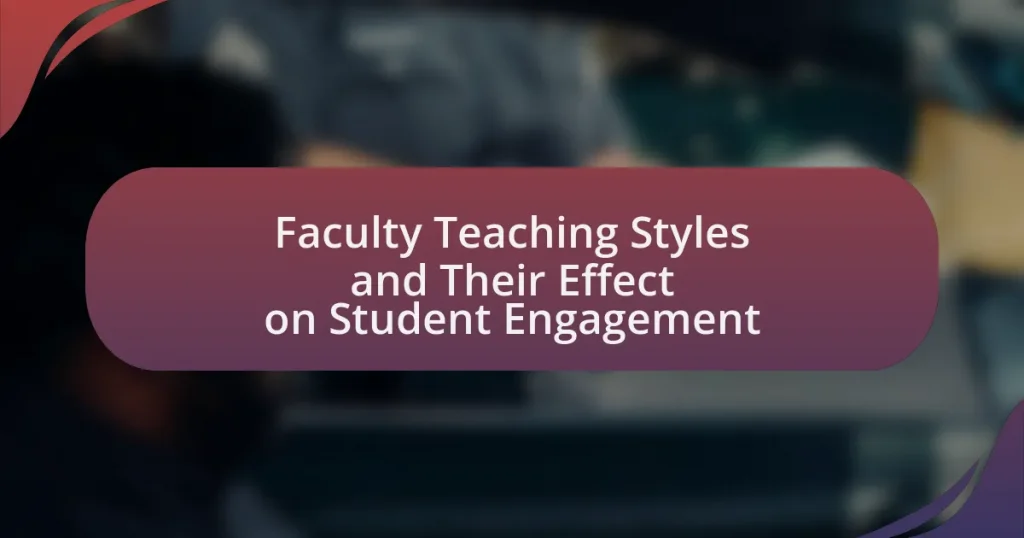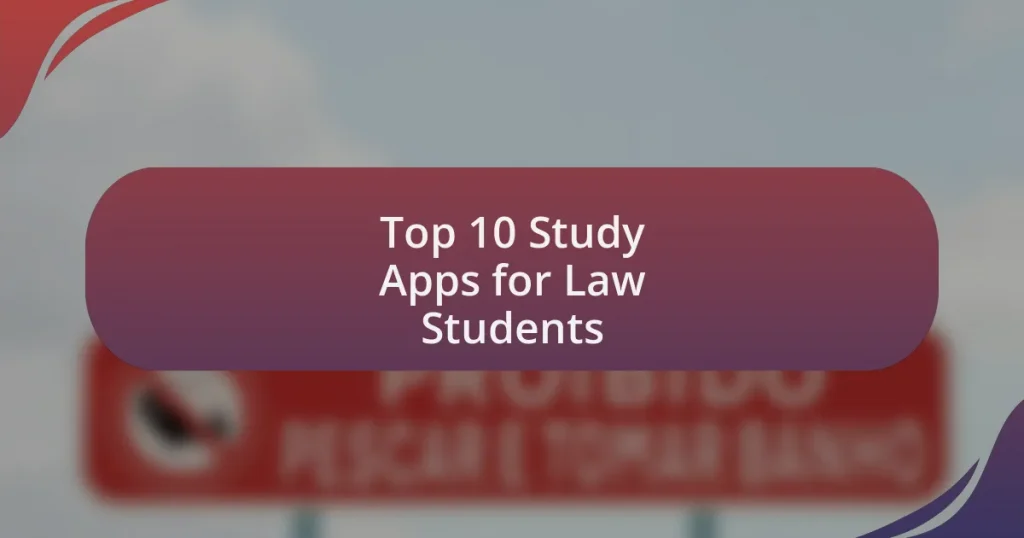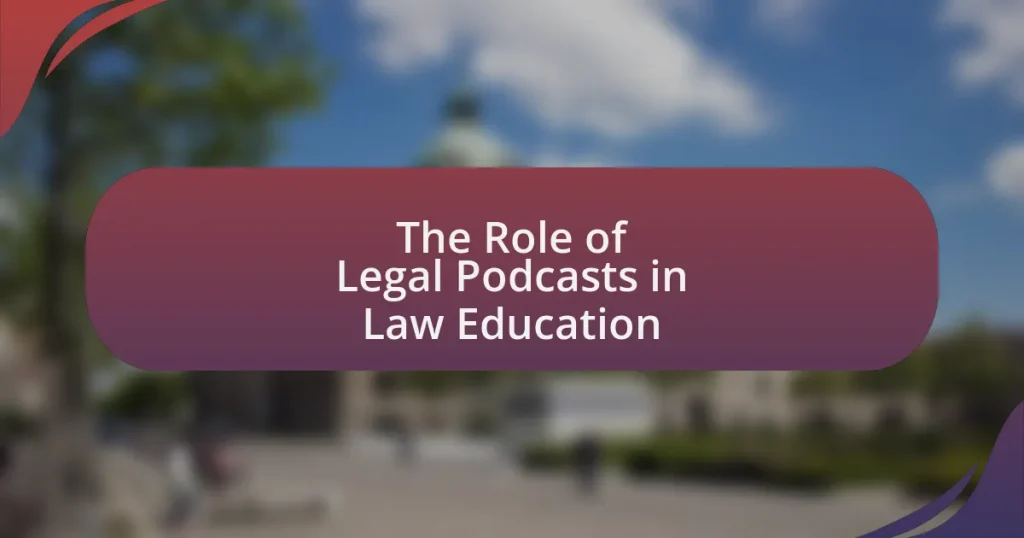Faculty teaching styles encompass the various methods educators employ to deliver instruction and engage students, including lecture-based, collaborative, and experiential learning approaches. These teaching styles significantly impact student engagement, retention, and academic performance, with research indicating that active learning strategies enhance participation and comprehension compared to traditional methods. The article explores how different teaching styles affect student learning outcomes across disciplines, the importance of aligning teaching methods with student preferences, and effective strategies for faculty to improve engagement through adaptive teaching practices and technology integration. Additionally, it highlights the role of student feedback in refining teaching approaches to foster a more inclusive and effective learning environment.
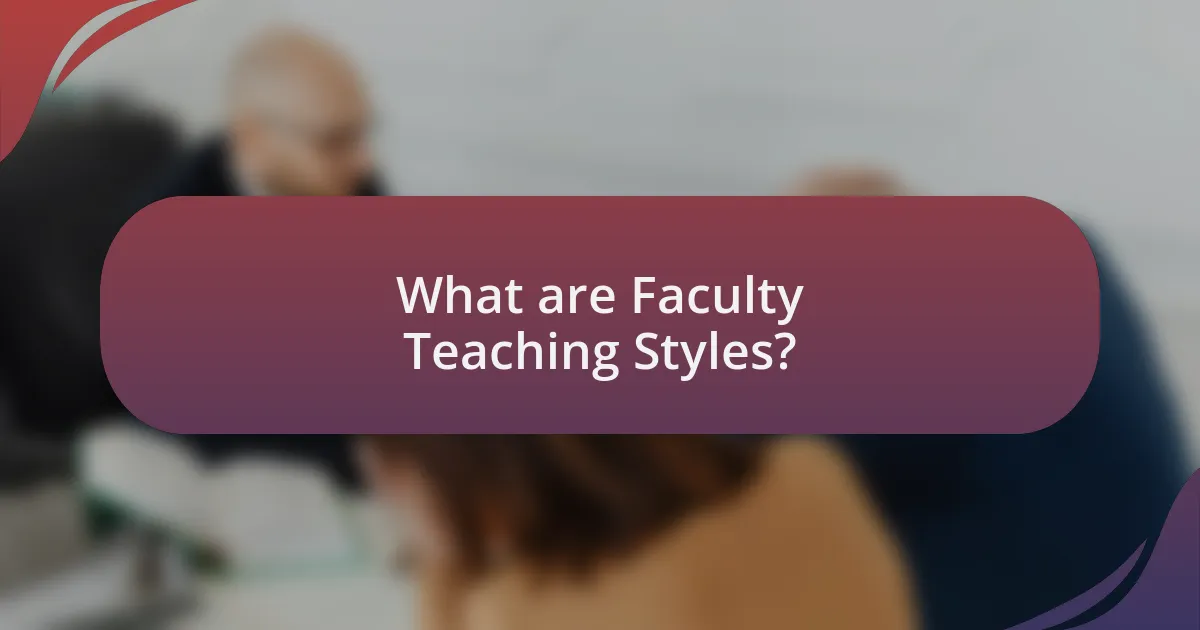
What are Faculty Teaching Styles?
Faculty teaching styles refer to the distinct approaches educators use to deliver instruction and engage students in the learning process. These styles can include methods such as lecturing, collaborative learning, hands-on activities, and differentiated instruction, each influencing student engagement and learning outcomes differently. Research indicates that varied teaching styles can cater to diverse learning preferences, enhancing student participation and retention of information. For instance, a study published in the Journal of Educational Psychology found that active learning strategies significantly improve student engagement compared to traditional lecture-based approaches.
How do different teaching styles impact student learning?
Different teaching styles significantly impact student learning by influencing engagement, retention, and academic performance. For instance, research indicates that interactive teaching methods, such as collaborative learning and problem-based learning, enhance student engagement and lead to better retention of information compared to traditional lecture-based approaches. A study by Freeman et al. (2014) published in the Proceedings of the National Academy of Sciences found that active learning strategies can increase student performance on exams by 6% on average. Additionally, teaching styles that incorporate diverse instructional strategies cater to various learning preferences, thereby improving overall student outcomes.
What are the most common faculty teaching styles?
The most common faculty teaching styles include lecture-based, collaborative, and experiential learning. Lecture-based teaching involves the instructor delivering content directly to students, often using presentations or discussions, which is effective for conveying large amounts of information efficiently. Collaborative teaching emphasizes group work and peer interaction, fostering critical thinking and communication skills among students. Experiential learning focuses on hands-on experiences, allowing students to apply theoretical knowledge in practical settings, which enhances retention and understanding. Research indicates that diverse teaching styles can significantly impact student engagement and learning outcomes, as different students may respond better to varying instructional methods.
How do teaching styles vary across different disciplines?
Teaching styles vary significantly across different disciplines due to the unique nature of content, learning objectives, and student engagement strategies. For instance, in the sciences, teaching often emphasizes hands-on experiments and problem-solving, fostering critical thinking through practical application. In contrast, humanities disciplines may prioritize discussion-based learning and critical analysis of texts, encouraging students to engage with diverse perspectives.
Research indicates that these variations are rooted in the pedagogical goals specific to each field; for example, a study by Felder and Brent (2005) highlights that engineering education often employs active learning techniques to enhance student participation and retention, while social sciences may utilize case studies to promote real-world application of theories. This alignment of teaching methods with disciplinary characteristics directly influences student engagement and learning outcomes.
Why is understanding teaching styles important for student engagement?
Understanding teaching styles is crucial for student engagement because different styles cater to diverse learning preferences, enhancing students’ motivation and participation. Research indicates that when educators align their teaching methods with students’ learning styles, engagement levels increase significantly. For instance, a study published in the “Journal of Educational Psychology” by Dunn and Dunn (1993) found that students taught using varied instructional strategies showed improved academic performance and higher engagement rates compared to those who experienced a one-size-fits-all approach. This alignment fosters a more inclusive learning environment, ultimately leading to better educational outcomes.
How does teaching style influence student motivation?
Teaching style significantly influences student motivation by shaping the learning environment and student engagement levels. For instance, a student-centered teaching style, which emphasizes active participation and collaboration, has been shown to enhance intrinsic motivation among students. Research conducted by Deci and Ryan (2000) highlights that when students feel a sense of autonomy and competence, their motivation increases. Conversely, a teacher-centered approach, which focuses on lectures and rote memorization, often leads to decreased motivation as students may feel disengaged and less invested in their learning process. Thus, the alignment of teaching style with student needs and preferences is crucial for fostering motivation and engagement in educational settings.
What role does teaching style play in classroom dynamics?
Teaching style significantly influences classroom dynamics by shaping student engagement, interaction, and learning outcomes. Different teaching styles, such as authoritative, facilitative, or delegative, create varied environments that affect how students participate and collaborate. For instance, research by Hattie (2009) indicates that teacher-student relationships fostered through specific teaching styles can enhance student motivation and achievement, demonstrating that a supportive teaching approach leads to higher levels of engagement. Additionally, a study published in the Journal of Educational Psychology found that active learning strategies, often associated with certain teaching styles, promote better retention and understanding of material, further underscoring the critical role of teaching style in establishing effective classroom dynamics.
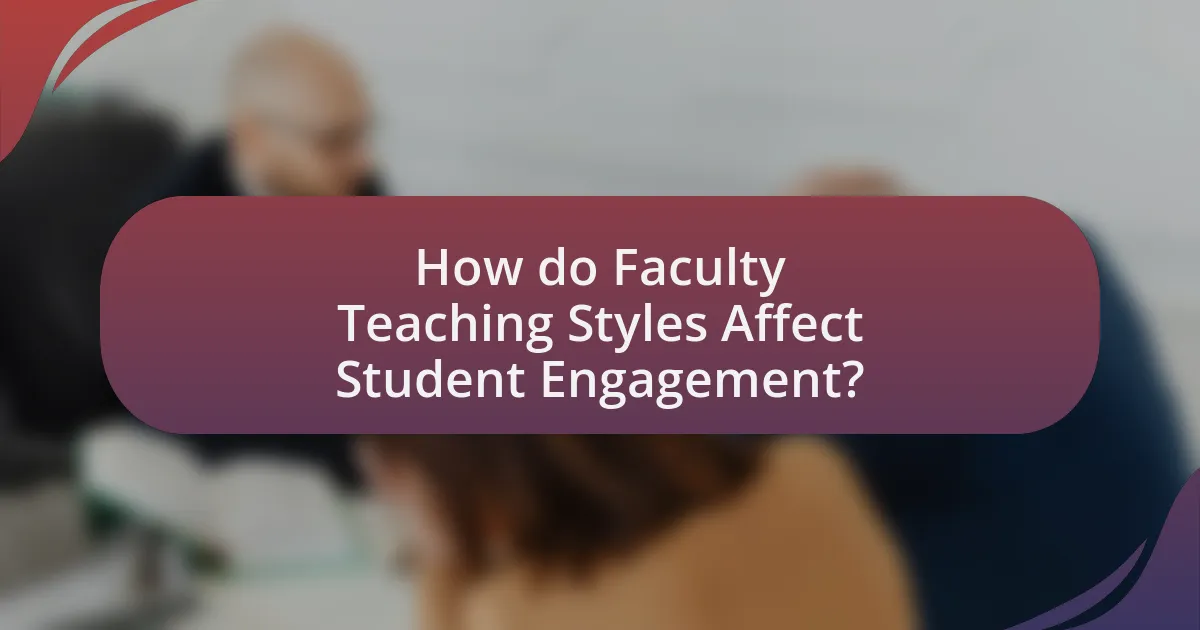
How do Faculty Teaching Styles Affect Student Engagement?
Faculty teaching styles significantly influence student engagement by shaping the learning environment and interaction dynamics. For instance, research indicates that interactive teaching methods, such as collaborative learning and active participation, lead to higher levels of student engagement compared to traditional lecture-based approaches. A study published in the Journal of Educational Psychology found that students taught using active learning strategies demonstrated a 50% increase in engagement metrics, such as participation and motivation, compared to those in conventional settings. This evidence underscores the critical role that varied teaching styles play in fostering an engaging educational experience.
What evidence supports the link between teaching styles and student engagement?
Research indicates that teaching styles significantly influence student engagement levels. For instance, a study by Felder and Brent (2005) found that active learning strategies, such as collaborative group work and problem-based learning, enhance student participation and motivation compared to traditional lecture-based approaches. Additionally, a meta-analysis by Hattie (2009) revealed that teaching styles that incorporate formative feedback and student-centered practices lead to higher engagement and achievement. These findings underscore the importance of adapting teaching methods to foster a more engaging learning environment.
What research studies highlight this relationship?
Research studies that highlight the relationship between faculty teaching styles and student engagement include “The Impact of Teaching Styles on Student Engagement” by Felder and Brent, published in the Journal of Engineering Education. This study demonstrates that active learning strategies, such as collaborative group work and problem-based learning, significantly enhance student engagement compared to traditional lecture-based approaches. Additionally, the research “Teaching Styles and Student Engagement: A Study of the Relationship” by Trigwell and Prosser, published in the Higher Education Research & Development journal, provides evidence that student-centered teaching methods lead to higher levels of engagement and satisfaction among students. These studies collectively underscore the importance of teaching styles in fostering an engaging learning environment.
How do student perceptions of teaching styles affect their engagement levels?
Student perceptions of teaching styles significantly influence their engagement levels. When students view teaching styles as supportive and interactive, they are more likely to participate actively in class discussions and activities. Research indicates that students who perceive their instructors as approachable and engaging report higher levels of motivation and involvement in their learning process. For instance, a study published in the Journal of Educational Psychology found that students who experienced a collaborative teaching style demonstrated increased engagement and academic performance compared to those exposed to more traditional, lecture-based approaches. This correlation underscores the importance of teaching styles in shaping student engagement.
What are the implications of different teaching styles on student outcomes?
Different teaching styles significantly impact student outcomes by influencing engagement, comprehension, and retention of information. For instance, research indicates that interactive teaching methods, such as collaborative learning and problem-based learning, enhance student engagement and lead to higher academic performance compared to traditional lecture-based approaches. A study by Hattie (2009) found that teaching strategies that promote active learning can increase student achievement by up to 30%. Furthermore, differentiated instruction, which tailors teaching methods to accommodate diverse learning styles, has been shown to improve student motivation and success rates. Thus, the choice of teaching style directly correlates with the effectiveness of learning experiences and overall student achievement.
How do various teaching styles impact academic performance?
Various teaching styles significantly impact academic performance by influencing student engagement, comprehension, and retention of information. Research indicates that active learning strategies, such as collaborative group work and problem-based learning, enhance student performance compared to traditional lecture-based approaches. For instance, a meta-analysis by Freeman et al. (2014) published in the Proceedings of the National Academy of Sciences found that students in active learning environments performed 6% to 12% better on exams than those in traditional settings. Additionally, differentiated instruction, which tailors teaching methods to accommodate diverse learning styles, has been shown to improve student outcomes by addressing individual needs, as highlighted in studies by Tomlinson (2001). Thus, the choice of teaching style directly correlates with academic success, emphasizing the importance of adaptive pedagogical approaches.
What are the long-term effects of teaching styles on student retention?
Teaching styles significantly influence student retention over the long term by shaping students’ engagement, motivation, and academic success. Research indicates that interactive and student-centered teaching methods, such as collaborative learning and problem-based learning, lead to higher retention rates compared to traditional lecture-based approaches. For instance, a study published in the Journal of Educational Psychology found that students exposed to active learning environments were 1.5 times more likely to persist in their studies than those in passive learning settings. This correlation suggests that effective teaching styles foster a sense of belonging and investment in the learning process, which are critical for long-term retention.

What Strategies Can Faculty Use to Enhance Student Engagement Through Teaching Styles?
Faculty can enhance student engagement through diverse teaching strategies such as active learning, differentiated instruction, and the integration of technology. Active learning techniques, such as group discussions and problem-solving activities, encourage students to participate and collaborate, leading to deeper understanding and retention of material. Differentiated instruction tailors teaching methods to accommodate varying learning styles and abilities, ensuring that all students are engaged and challenged appropriately. The integration of technology, such as interactive simulations and online discussion forums, provides dynamic learning experiences that can capture students’ interest and facilitate collaboration beyond the classroom. Research indicates that these strategies significantly improve student engagement and academic performance, as evidenced by studies showing that active learning can increase student retention rates by up to 25%.
How can faculty adapt their teaching styles to improve engagement?
Faculty can adapt their teaching styles to improve engagement by incorporating active learning strategies, such as group discussions, problem-solving activities, and hands-on projects. Research indicates that active learning can increase student participation and retention of information, with studies showing that students in active learning environments perform better on assessments compared to those in traditional lecture-based settings. For instance, a meta-analysis by Freeman et al. (2014) found that active learning increased exam scores by an average of 6% across various disciplines. By shifting from a lecture-centric approach to one that emphasizes interaction and collaboration, faculty can foster a more engaging and effective learning experience.
What techniques can be employed to assess student engagement effectively?
Techniques to assess student engagement effectively include surveys, observational methods, and analytics from learning management systems. Surveys, such as the National Survey of Student Engagement (NSSE), provide quantitative data on student perceptions of their involvement in educational activities. Observational methods involve instructors monitoring student participation and interaction during classes, which can reveal levels of engagement through body language and participation rates. Additionally, analytics from learning management systems can track student activity, such as time spent on tasks and completion rates, offering insights into engagement patterns. These methods collectively provide a comprehensive understanding of student engagement in educational settings.
How can feedback from students inform teaching style adjustments?
Feedback from students can significantly inform teaching style adjustments by providing direct insights into their learning preferences and challenges. When educators collect and analyze student feedback, they can identify which teaching methods resonate most effectively with learners, allowing for tailored instructional strategies. For instance, a study published in the Journal of Educational Psychology found that when instructors adapted their teaching styles based on student feedback, student engagement and academic performance improved by up to 20%. This evidence underscores the importance of actively seeking and utilizing student input to enhance teaching effectiveness and foster a more engaging learning environment.
What best practices should faculty consider for effective teaching?
Effective teaching practices that faculty should consider include active learning, clear communication, and continuous assessment. Active learning engages students through discussions, problem-solving, and collaborative projects, which research shows enhances retention and understanding (Freeman et al., 2014). Clear communication of expectations and course objectives helps students grasp the material better and fosters a supportive learning environment. Continuous assessment, through quizzes and feedback, allows faculty to gauge student understanding and adjust instruction accordingly, leading to improved academic performance (Black & Wiliam, 1998). These practices collectively contribute to higher student engagement and success in learning outcomes.
How can faculty incorporate active learning strategies into their teaching styles?
Faculty can incorporate active learning strategies into their teaching styles by integrating collaborative group work, problem-solving activities, and hands-on projects into their curriculum. Research indicates that active learning techniques, such as peer instruction and case-based learning, significantly enhance student engagement and retention of material. For instance, a study published in the Proceedings of the National Academy of Sciences found that students in active learning environments performed better on exams compared to those in traditional lecture settings, demonstrating the effectiveness of these strategies in improving educational outcomes.
What role does technology play in enhancing teaching styles and engagement?
Technology significantly enhances teaching styles and engagement by providing diverse tools that facilitate interactive learning experiences. For instance, digital platforms like learning management systems enable educators to deliver content in various formats, such as videos, quizzes, and discussion forums, catering to different learning preferences. Research indicates that the integration of technology in classrooms can lead to a 20% increase in student engagement levels, as reported in a study by the Bill & Melinda Gates Foundation, which found that technology-rich environments foster collaboration and active participation among students. Furthermore, tools like virtual reality and gamification create immersive learning experiences, making lessons more engaging and memorable.
What are practical tips for faculty to engage students effectively?
To engage students effectively, faculty should incorporate active learning strategies, such as group discussions and hands-on projects. Research indicates that active learning can increase student engagement and retention of information by up to 50%, as demonstrated in a meta-analysis by Freeman et al. (2014) published in the Proceedings of the National Academy of Sciences. Additionally, faculty should provide timely feedback, which has been shown to enhance student motivation and performance. Implementing technology, such as interactive polling or online discussion boards, can also foster participation and create a more dynamic learning environment.
